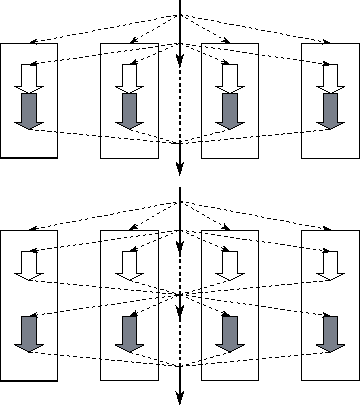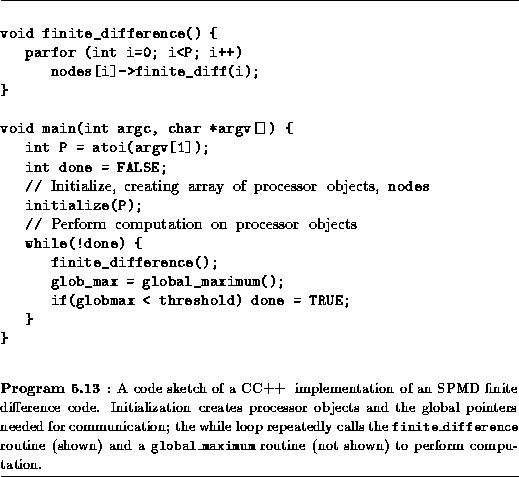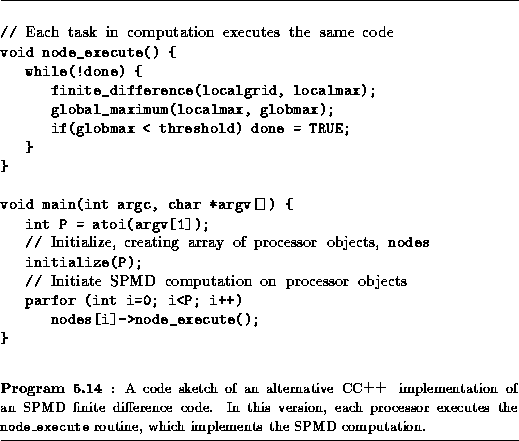![[DBPP]](pictures//asm_color_tiny.gif)





![[Search]](pictures//search_motif.gif)
Next: 5.10 Performance Issues
Up: 5 Compositional C++
Previous: 5.8 Mapping
Example 5.5 showed how CC++
constructs can be used to
implement parallel and concurrent composition. The basic ideas are
straightforward: each component
of a multicomponent program is
implemented as a distinct task. Each such task is passed an array of
proc_t objects representing its computational resources. The
task creates a distinct set of processor objects and performs mapping
and communication with respect to these proc_t objects and
processor objects.
In this section, we discuss the techniques used to implement
sequential
composition in CC++
programs. Recall that in
sequential composition, different program components execute in
sequence on all processors (Section 4.2.2). These
program components may themselves communicate and synchronize, but
they cannot create new tasks. Hence, each process executes the same
program, and the entire computation moves sequentially from one
parallel operation to the next. This is the single program multiple
data (SPMD) programming model discussed in Section 1.3.2.
A CC++
implementation of an SPMD program comprises two components.
The initialization
component creates the processor objects
in which computation will be performed and the communication
structures (such as channels) required by the program components
called in the sequential composition. The execution
component performs the actual computation, using the structures
created during the initialization phase. The execution component can
be structured in two different ways (Figure 5.7). In
the first approach, the top-level program is structured as a sequence
of calls to routines that each use a parfor statement to create
a thread on each processor object. In the second approach a single
parfor statement creates a set of long-lived threads (one per
processor object) that each make a sequence of calls to the various
routines involved in the sequential composition. The first approach
can lead to simpler programs, but the latter tends to be more
efficient.

Figure 5.7: Two alternative approaches to the implementation of sequential
composition in CC++
. The two figures are timelines, with the parent
thread shown as a solid dark line when active and a dashed dark line
when suspended. In both cases, an initialization phase creates the
four processor objects in which computation will occur. In the first
approach, a set of long-lived threads is then created; each of these
threads executes both components before terminating. In the second
approach, control returns to the parent thread after the first
component executes; the parent thread then creates a new set of
threads for the second component.
Example  .
. Finite Difference:
Finite Difference:
We apply the two approaches to the SPMD finite difference computation
used to illustrate sequential composition in
Section 4.2.2. This computation is structured as a
sequence of calls to a finite difference routine that performs
nearest-neighbor communication and a reduction routine used to detect
termination; the latter routine performs global communication.
An implementation of this algorithm using the first approach is
illustrated in Program 5.13. The execution component is
structured as a while loop containing a sequential composition of
parallel finite_difference and global_maximum routines.
Concurrency and communication are encapsulated in these routines,
which use parfor and other parallel constructs to create threads
of control within the processor objects created in the initialization
phase.
The second approach is illustrated in Program 5.14.
Here, a single parfor statement creates one thread of control in
each processor object. This thread makes a sequence of calls to
routines that call local finite_difference and
global_maximum routines. The resulting program is more complex but
potentially more efficient, as it avoids the cost of repeatedly
creating and destroying the threads used to perform the SPMD
computation.


![[DBPP]](pictures//asm_color_tiny.gif)





![[Search]](pictures//search_motif.gif)
Next: 5.10 Performance Issues
Up: 5 Compositional C++
Previous: 5.8 Mapping
© Copyright 1995 by Ian Foster

![[DBPP]](pictures//asm_color_tiny.gif)





![[Search]](pictures//search_motif.gif)
 .
. Finite Difference:
Finite Difference:

